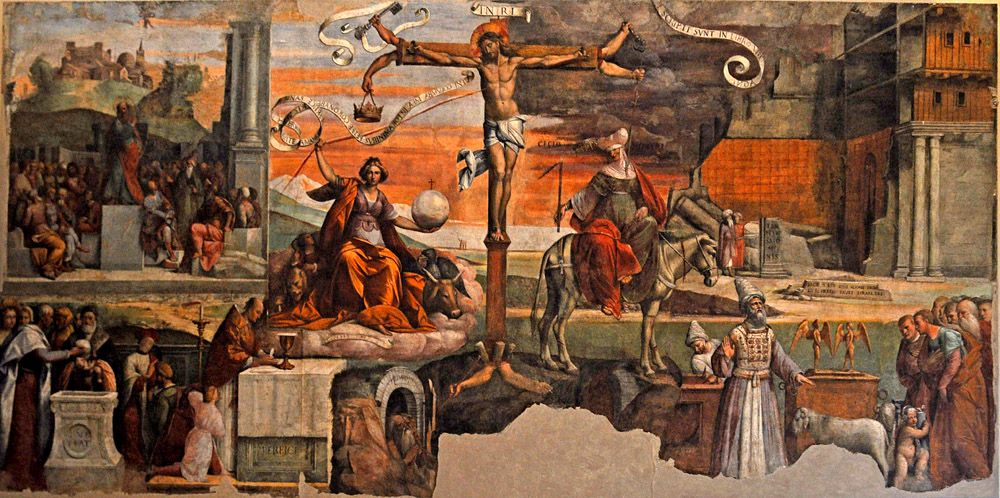Garofalo (Benvenuto Tisi), The Old and New Testaments

1523
Fresco
Pinacoteca Nazionale, Ferrara
The female figures flanking the crucifix are Ecclesia and Synagoga. This fresco makes the same basic point as simpler Church/Synagogue images, contrasting the definitively salvific sacrifice of Christ on the cross with the unavailing sacrifices prescribed in Leviticus. On the left, Ecclesia channels the blood flowing from Christ's side to the sacraments of Baptism, Penance, and the Eucharist. On the right, Synagoga presides over the sacrifice of rams by a Jewish high priest. She sits blindfolded on a lame ass and carries a broken scepter, whereas Ecclesia sits among the symbols of the evangelists, holds a
mappa mundi
A globe with one horizontal circle and one vertical half-circle, topped by a cross, the mappa mundi stands for the bearer's reign over the earth. Usually it is Christ who is pictured holding it.
and looks out to the viewer, clear-eyed and confident.
This theme arises from the ninth chapter of the Letter to the Hebrews, which was thought to be Authored by St. Paul. Thus the central figure in the inset on the left is probably Paul, building the spiritual Church through his preaching. In contrast, the physical temple labeled templum salomonis, "Temple of Solomon," is in ruins on the right. Before the Temple is a broken stone with the words factus est dominus velut inimicus precipitavit Israel, "The Lord is become as an enemy: he hath cast down Israel headlong" (Lamentations 2:5).
On the left, the arms sprouting from the cross hold Peter's keys, Ecclesia's crown, and a cross representing Christ's rescue of the just souls in "Limbo" (so labeled) just before the Resurrection. The arms on the right are harder to make out, but the first one holds a broken key and the second seems related to the spear that pierces Synagoga's breast.
The banderole floating on the right bears the final phrase of Revelation 21:27, "There shall not enter into it [Heaven] any thing defiled, or that worketh abomination or maketh a lie, but they that are written in the book of life of the Lamb." On the left, the banderole below the crown combines verses 2:13c 2:14a, and 4:8b-c from the Song of Solomon: veni columba mea in foraminibus petre coronaberis de capite amana de vertice sanir et hermon, "Come, my dove, in the clefts of the rock thou shalt be crowned from the top of Amana, from the top of Sanir and Hermon." The Glossa Ordinaria interprets the three mountaintops as places inhabited by lions that symbolize "the devils who rage against us." Nicholas of Lyra adds that the mountains are in the Transjordan, from whence the Israelites first beheld the beauty of the land promised to them (III, 1849). The Bride of the Song thus represents Ecclesia, called away from this world of dangers to the New Jerusalem.
View this image in full resolution.
Read more about images of The Crucifixion.
Read more about images of Ecclesia and Synagoga.
Photographed at the site by Richard Stracke, shared under Attribution-NonCommercial-ShareAlike license.